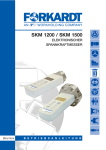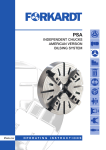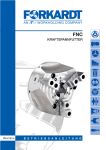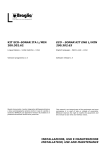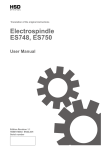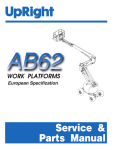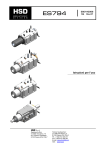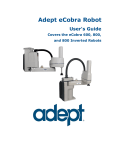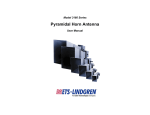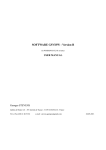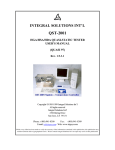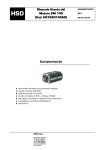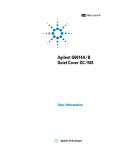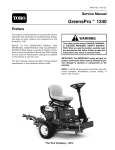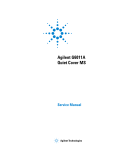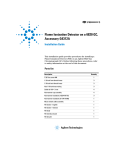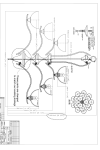Download Forkardt Powerchuck Manual UBL ABL
Transcript
UBL / ABL UNIVERSAL BALL-LOK CHUCKS E NGLISH OPERATING INSTRUCTIONS BA-Nr.: UBL/ABL.E CONTENTS Edition: 01/2014 Contents 1.0 1.1 General information on documentation . . . . . . . . . . . . . . . . . . . . . . . . . . . . . . . . . .3 Explanation of the symbols . . . . . . . . . . . . . . . . . . . . . . . . . . . . . . . . . . . . . . . . . . . . . .3 2.0 2.1 2.2 2.3 2.4 2.5 2.6 General safety advice . . . . . . . . . . . . . . . . . . . . . . . . . . . . . . . . . . . . . . . . . . . . . . . . .4 General . . . . . . . . . . . . . . . . . . . . . . . . . . . . . . . . . . . . . . . . . . . . . . . . . . . . . . . . . . . . .4 Intended Use . . . . . . . . . . . . . . . . . . . . . . . . . . . . . . . . . . . . . . . . . . . . . . . . . . . . . . . . .4 Transport, handling and storage . . . . . . . . . . . . . . . . . . . . . . . . . . . . . . . . . . . . . . . . . .5 Operating information . . . . . . . . . . . . . . . . . . . . . . . . . . . . . . . . . . . . . . . . . . . . . . . . . .5 Maintenance and repair . . . . . . . . . . . . . . . . . . . . . . . . . . . . . . . . . . . . . . . . . . . . . . . . .5 Safety technology conditions for clamping devices . . . . . . . . . . . . . . . . . . . . . . . . . . .6 3.0 3.1 3.2 3.3 3.4 3.5 3.6 3.7 3.7.1 Set up and function . . . . . . . . . . . . . . . . . . . . . . . . . . . . . . . . . . . . . . . . . . . . . . . . . . .7 Description . . . . . . . . . . . . . . . . . . . . . . . . . . . . . . . . . . . . . . . . . . . . . . . . . . . . . . . . . .7 Jaws and grippers . . . . . . . . . . . . . . . . . . . . . . . . . . . . . . . . . . . . . . . . . . . . . . . . . . . . .7 Maintenance . . . . . . . . . . . . . . . . . . . . . . . . . . . . . . . . . . . . . . . . . . . . . . . . . . . . . . . . .7 Installation . . . . . . . . . . . . . . . . . . . . . . . . . . . . . . . . . . . . . . . . . . . . . . . . . . . . . . . . . . .8 Disassembly . . . . . . . . . . . . . . . . . . . . . . . . . . . . . . . . . . . . . . . . . . . . . . . . . . . . . . . . .9 Assembly . . . . . . . . . . . . . . . . . . . . . . . . . . . . . . . . . . . . . . . . . . . . . . . . . . . . . . . . . . . .9 Troubleshooting and grease information . . . . . . . . . . . . . . . . . . . . . . . . . . . . . . . . . .12 Recommended Chucking Ranges . . . . . . . . . . . . . . . . . . . . . . . . . . . . . . . . . . . . . . .13 4.0 4.1 4.2 4.3 4.4 4.5 4.6 4.7 Assembly . . . . . . . . . . . . . . . . . . . . . . . . . . . . . . . . . . . . . . . . . . . . . . . . . . . . . . . . . .14 Introduction . . . . . . . . . . . . . . . . . . . . . . . . . . . . . . . . . . . . . . . . . . . . . . . . . . . . . . . .14 Index . . . . . . . . . . . . . . . . . . . . . . . . . . . . . . . . . . . . . . . . . . . . . . . . . . . . . . . . . . . . . .14 Disassembled illustration - Each part's name . . . . . . . . . . . . . . . . . . . . . . . . . . . . . .15 Disassembling procedure of UBL chuck - ① ~ ⑩ . . . . . . . . . . . . . . . . . . . . . . . . . . .16 Component parts of jaw actuator - ① ~ ③ . . . . . . . . . . . . . . . . . . . . . . . . . . . . . . . .21 Checking of the condition of component parts - ① ~ ④ . . . . . . . . . . . . . . . . . . . . . .23 Re-assembling of UBL chuck - ① ~ ⑥ (Placing of housing / actuator / eccentric ball) . . . . . . . . . . . . . . . . . . . . . . . . . . . . .25 Re-assembling of UBL chuck - ① ~ ⑥ . . . . . . . . . . . . . . . . . . . . . . . . . . . . . . . . . . . . . (Jaw actuator part) . . . . . . . . . . . . . . . . . . . . . . . . . . . . . . . . . . . . . . . . . . . . . . . . . . .28 Re-assembling of UBL chuck - ① ~ ⑤ (Placing jaw actuator into housing) . . . . . . . . . . . . . . . . . . . . . . . . . . . . . . . . . . . . . . .31 Re-assembling of UBL chuck - ① ~ ③ . . . . . . . . . . . . . . . . . . . . . . . . . . . . . . . . . . . . . (Placing back plate) . . . . . . . . . . . . . . . . . . . . . . . . . . . . . . . . . . . . . . . . . . . . . . . . . . .34 4.8 4.9 4.10 2 5.0 5.1 5.2 Spare parts and service . . . . . . . . . . . . . . . . . . . . . . . . . . . . . . . . . . . . . . . . . . . . . .36 Spare parts . . . . . . . . . . . . . . . . . . . . . . . . . . . . . . . . . . . . . . . . . . . . . . . . . . . . . . . . .36 Customer service . . . . . . . . . . . . . . . . . . . . . . . . . . . . . . . . . . . . . . . . . . . . . . . . . . . .36 6.0 Declaration of incorporation . . . . . . . . . . . . . . . . . . . . . . . . . . . . . . . . . . . . . . . . . .37 BA-Nr.: UBL/ABL.E Edition: 01/2014 GENERAL INFORMATION ON DOCUMENTATION 1.0 General information on documentation This user manual contains the essential information for the proper use of the clamping device. It is addressed to technically qualified people. Qualified people are: • those who have received instruction on using the clamping device. • those who have received training on setting up and repairing clamping devices, and work as repair and servicing staff. ☞ For the operation, maintenance and repair of the clamping device it is essential that the information in this manual is read and understood. We reserve the right to make technical changes to the descriptions and statements in this instruction manual that are essential to improve the clamping device. The manual may not be copied, disseminated or used for competitive purposes in full or in part. The copyright for this manual belongs to FORKARDT DEUTSCHLAND GMBH. 1.1 Explanation of the symbols Safety advice to prevent danger to life or reduce damage to property is shown in this manual by the symbols and pictograms indicated here. indicates potential risk. Death, severe physical injury or substantial damage to property may occur if the precautions are not undertaken or the safety advice not adhered to. ☞ i indicates important information on avoiding damage to property or undesirable operating states. indicates information on handling or additional information. 3 BA-Nr.: UBL/ABL.E GENERAL SAFETY ADVICE Edition: 01/2014 2.0 General safety advice 2.1 General Clamping devices may produce risks if the use and handling do not meet the requirements for safety technology. The clamping device is produced to the current state of the technology and is safe to operate. Even so this clamping device may produce risks if it is used improperly by unqualified people. The following information is to be used for personal safety and to prevent damage to the product described or the connected devices. Read this manual before working with the clamping device and observe all safety information. Not adhering to the instructions contained in this manual may result in danger to life, severe personal injury or substantial damage to property. • Only qualified people may work with the clamping device. • It is not permitted to change or alter the clamping device yourself. • Only use the clamping device when it is in perfect condition. • Before working on the clamping device, switch the machine off and ensure it can not be switched on again. • Only use original manufacturer components and spare parts. The warranty lapses if parts from other manufacturers are used. • Before starting to use the clamping device check whether all protective devices have been attached. • The "lathe – clamping device – work piece" system is primarily influenced by the work piece being produced, which may result in a remaining risk. The operator must assess the remaining risk. The manufacturer is not liable for damage arising from not adhering to the manual. 2.2 Intended Use The clamping device may only be used to clamp workpieces on machine tools. When doing so the maximum axial force, clamping force and revolutions of the clamping device may not be exceeded. The required clamping force must be determined for the application in line with the applicable technical rules (e.g. VDI 3106). If in doubt or if accessories are used that were not provided by the manufacturer, the manufacturer must approve or restate the thresholds. The following must be considered: 4 • Variable adhesion coefficients between work piece and top jaw • Relationship between clamping diameter and working diameter BA-Nr.: UBL/ABL.E GENERAL SAFETY ADVICE Edition: 01/2014 • • • • • Size of cutting force on the cutting tool Top jaws overhang from the clamping location Reduction in clamping force via the centrifugal force for external clamping The maximum revs stated only apply to hard standard top jaws For special top jaws that are to be used for this chuck the maximum revs are engraved on the jaws Proper use includes adhering to the manufacturer's prescribed assembly, set-up, operation and maintenance terms. All other uses are considered to be unauthorised. The manufacturer is not liable for damage thus caused. 2.3 Transport, handling and storage Notify the forwarder if there is transport damage. Notify the manufacturer in writing without delay if parts are missing. If the clamping device is not assembled immediately after delivery it must be stored in a protected location. Cover the parts properly and protect from dust and moisture. In order to protect all the blank parts, the clamping device and pressure oil cylinder, and all accessories are covered with a protective substance on delivery. 2.4 Operating information As per the regulations of the trade association, revolving clamping devices must be secured from touching using appropriate covers or protective doors. If faults occur on the clamping device during operation, the machine must be switched off immediately and only restarted when the fault has been resolved. After switching off the clamping power the work piece may release itself from the clamping device. The local safety regulations and accident prevention rules of the appropriate trade association apply to operating the clamping device. 2.5 Maintenance and repair For maintenance and monitoring work ensure the clamping device is without pressure. At the high revs that are common on lathes, the clamping device is exposed to high loads. It can be damaged during collisions between the tool and clamping device that may occur occasionally, e.g. if the program process has faults damage may occur. 5 BA-Nr.: UBL/ABL.E GENERAL SAFETY ADVICE Edition: 01/2014 After a collision switch off the lathe immediately and check the clamping device for damage. In addition to easily recognised damage, hidden damage may also occur, e.g. hairline fractures in the chuck body or the base jaws. Remove the clamping device immediately from the machine spindle. Analyse the affected parts of the clamping device with an appropriate, non-destructive testing procedure to ensure there are no fractures and exchange it if damage has occurred. ☞ 2.6 Only use original parts. Safety technology conditions for clamping devices The safety technology conditions for operating clamping devices under pressure are defined in the trade association's testing guidelines and the DIN, VDE and VDI guidelines. The individual test conditions are ensured via the following activities: 6 Test condition Ensured via: The machine spindle may only start when the minimum clamping pressure in the clamping cylinder has been built up. Pressure switch in the clamping lines The machine spindle may only start if the jaw stroke clamping is in the permitted range. Clamping route monitoring on the actuating cylinder The clamping may only be released when the machine spindle has stopped. Standstill monitoring on the machine spindle If the clamping energy fails the work piece remains clamped until the spindle stops. Unlockable non-return valve in actuating cylinder If the power fails and restarts the switching detent positions do not change. Impulse-controlled way valve with end positions If the clamping energy fails, a signal to automatically or manually stop the spindle is given. At 1/5 of the maximum activation power the clamping device used must open and close. Pressure switch in the clamping line BA-Nr.: UBL/ABL.E SET UP AND FUNCTION Edition: 01/2014 3.0 Set up and function 3.1 Description The 3 jaw centralizing or compensating chuck is a sealed unit, designed for excellent performance, durability and ease of maintenance. Its chucking action is achieved by a ball joint mechanism. Utilizing its radial and pull-back jaw stroke, draft angles of up to 5 degrees can be safely gripped. 3.2 Jaws and grippers Jaw safety screws (see chuck schematic) retain the t-nuts in the ball arms. It is very important that they are not removed and remain fully tightened. Special jaws can be designed to enhance the utilization of the chuck. Please consult the Forkardt sales office for further information. Part prints and process sheets will be required to complete the design. The UBL is now available with post style arm quick change jaw solution. Please contact our sales office for more information. 3.3 Maintenance At a minimum drawbar pull, check to ensure the chuck actuates smoothly. If this test results in a rough or uneven actuation, apply the recommended grease, Chevron Coupling Grease or equivalent, until the relief valve shows signs of excess grease. It is recommended to establish a preventive maintenance schedule. Visual inspection, operator care and periodic PM will enhance and extend the life of the unit. Depending on the severity of this environment, it is recommended that the chuck be disassembled and visually inspected for wear signs in the arms, bearings and actua- tor every 6 months. If considerable wear is detected, replace the parts immediately. Replacement arm kits and seal kits are available upon request. The Forkardt service department offers repair services with original manufacturers warranty covering all parts and labor. 7 BA-Nr.: UBL/ABL.E SET UP AND FUNCTION Edition: 01/2014 3.4 Installation 1. Remove dust cap and top tooling as required to make mounting screw holes accessible. 2. Position machine drawbar in the fully retracted position. 3. Support the chuck with a sling or eye bolt. 4. Mount basic chuck assembly to machine spindle SECURELY. If a chuck adapter is included, mount securely to your spindle first, then mount chuck to adapter. 5. Insert the chuck mounting screws and tighten per the table 1 enclosed. 6. Position machine drawbar in the full forward position. Fasten chuck actuator to the machine drawbar SECURELY with the drawbar bolt furnished. Set machine drawbar operation pressure as specified on assembly drawing to produce proper chucking pressure. DO NOT EXCEED RECOMMENDED MAX PRESSURE SHOWN ON ASSEMBLY PRINT. Check the installation and jaw stroke by opening and closing the chuck. 7. Retighten the drawbar bolt and replace dust cap and top tooling. 8. Make sure the unit is well lubricated using Chevron Coupling Grease or equivalent, and fully actuate the chuck a few times before use. For chucks with stiraround truing feature, follow above instructions while also adding these additional steps 9-12. 9. After performing steps 1-3 above, remove the sub adapter from the chuck and mount securely to the machine spindle. 10. Mount the chuck assembly to the sub adapter by HAND TIGHTENING the mounting screws. When tightening the draw bolt, only HAND TIGHTEN for now. 11. Set machine drawbar pressure at a low setting. Use the set screws spaced around the OD of the chuck adapter to adjust the chuck to run true, while indicating the central ID of the chuck body or a master part. (Set up master furnished at extra cost). Loosen the stir screw once the chuck is positioned. NEVER leave stir screws in a high torque state. 12. Once chuck is running true, tighten the mounting screws per Table 1. Open the chuck and tighten the drawbar bolt SECURELY. Very carefully snug up the stir screws. DO NOT overtighten. 13. Follow instructions 7 & 8 above. 8 BA-Nr.: UBL/ABL.E SET UP AND FUNCTION Edition: 01/2014 3.5 3.6 Disassembly 1. Remove all top tooling and clean the outside of the chuck. Set chuck on its face. 2. Remove back adapter plate (spindle adapter should still be on machine). 3. Remove exposed grease from inside of the chuck. 4. Remove caps, at base of arms, and springs (if applicable). 5. Place chuck on its side to remove the arms. 6. To remove the arms, first remove the 4 SHCS from upper bearing and tap the bottom of the arm to remove it. Make sure to keep the bearings, homing pins, spring and restrictor pin in sets. Repeat for each arm. 7. Remove actuator from housing (remove actuator support from actuator, if applicable) by removing the tru-arc ring and spacer. 8. Remove lower ball (eccentric ball) out of actuator. Removal is done by twisting the ball to proper location and pulling outward. 9. Clean all details for inspection. Assembly 1. Place the lower ball (eccentric ball) into the actuator, making sure balls move freely. 2. If compensating model, mount center actuator support and assemble with spacer and tru-arc ring. 3. Install actuator into housing. Actuator on centralizing models has two positioning lugs on 1 ear of actuator. This ear (with lugs) must be loaded into #1 bore (marked on top face of housing) of housing. On compensating models, the two positioning lugs are removed, but this ear must still be positioned into the #1 bore as well. 4. Once actuator is properly place into housing, turn over for assembly of arms and upper bearing. Place key in lower shaft of arm. 5. Place seal on arm, with Teflon cover facing the ball of the arm. 6. Place restrictor pin, into restrictor spring, and then place both into center hole of arm ball. 7. Place homing pins into center hole of arm ball, with flat face to top arm platform. 8. Vice clamps or equivalent will be required. Place the upper bearing around the arm (making sure that the seal is seating within the seal groove). Using aforementioned clamps, squeeze the bearing together, ensuring that homing pins are pushed in. Using a hose clamp (or similar), make sure that bearing is clamped securely around arm. 9 BA-Nr.: UBL/ABL.E SET UP AND FUNCTION Edition: 01/2014 9. Set the arm assembly into the arm cavity making sure the key in the arm and the key-way in lower ball are in line. Remove hose clamp and slide arm assembly into place and tap upper bearing down until arm and bearing are flush with top face of housing. Secure this assembly in place with 4 mounting screws. Repeat with remaining arms. 10. Place chuck on its face. 11. Fill the back side of chuck (with inner actuator exposed) with Chevron Coupling Grease or equivalent. Replace cap and springs. 12. Place the adapter back onto chuck body. Precaution must be taken to secure all items against the effect of rotation. 10 BA-Nr.: UBL/ABL.E SET UP AND FUNCTION Edition: 01/2014 Service Kits #1 Hardware Kit #2 ECC Ball Kit #3 Arm Kit #4 Tee Nut Kit #5 Upper Bearing Kit #6 Compensating Kit (3) arm seal (3) eccentric bearing (1) front bearing (3) t-nut (3) front bearing (1) retaining spacer (3) arm key (1) arm seal (3) safety screw (3) arm seal (1) retaining ring 3) restrictor pin (1) restrictor pin (6) jaw screw (3) homing spring (1) homing spring (3) spring cap (1) spring cap (3) arm key (1) arm key (1) pipe plug (1) arm (3) arm spring (1) arm spring (4) grease fittings (2) homing pin (6) homing pin (1) centralizing pin *When ordering service kits, please reference chuck type and size and kit number. If your chuck requires repair beyond replacement of wear parts, please contact our service department for assistance. 11 BA-Nr.: UBL/ABL.E SET UP AND FUNCTION Edition: 01/2014 METRIC SCREWS PROPERTY CLASS: 12.9 SCREW SIZE M4 (.7) M5 (.8) M6 (1.0) TORQUE N-m 4.6 9.5 16 M8 (1.25) M10 (1.5) M12 (1.75) 39 M14 (2.0) M16 (2.0) M18 (2.5) M20 (2.5) M22 (2.5) 135 215 330 455 650 870 5/8-11 3/4-10 7/8-9 1.0-8 43,500 3,400 6,000 8,400 12,500 77 INCH SCREWS PROPERTY CLASS: SAE J429 BLADE S SCREW SIZE TORQUE IN-LBS 1/4-20 5/16-18 3/8-16 200 425 300 7/16-14 1 1/2-13 1200 JAW FORCE AND RPM SPECS CHUCK DIAMETER (IN) 6 8 10 12 15 18 MAX RPM 3,000 2,400 1,875 1,650 1,275 1,025 JAW FORCE PER JAW (LBS) 6,100 8,100 10,000 12,100 15,100 15,100 3.7 Troubleshooting and grease information Grease your chuck at regular intervals. Grease will dissipate based on cycles. It is recommended to grease the chuck daily. Indications of low grease, or lack of greasing are run out and / or loss of grip force (possible part slippage). 12 • Recommended grease for the UBL chuck is Chevron Coupling grease (factory supplied). • Without a part in place, apply grease to each arm fitting (3 - 5 shots) along the outside diameter, until grease is released from the pipe plug. The lower fitting should get more grease as this is the one that will pop the pressure valve. • Actuate the chuck at full stroke approx. 5 to 10 times. This will further distribute grease throughout the chuck. • Re-apply grease to the chuck until the grease is released. • Another source of part slippage is cylinder pressure. Ensure that cylinder pressure is at the recommended level. • If part roundness is deteriorating, the jaw homing may not be functioning properly. To check this, use a wrench to “twist” the arm, without a part loaded. If the jaw does not snap back into position. Loosen the screws that hold the top bearing in place. Clamp the part and re-tighten the screws. Run a test part to ensure that the issue has been resolved. • If you hear a noise, similar to a clunk, during actuation, this could be an indication your drawbar has become loose and is not secure. BA-Nr.: UBL/ABL.E SET UP AND FUNCTION Edition: 01/2014 3.7.1 Recommended Chucking Ranges „A“ Diameter External Mode „B“ Diameter UBL size Internal Mode ”A” Diameter External Chucking Range (Recommended) ”B” Diameter Internal Chucking Range (Recommended) maximum / minimum maximum / minimum 160 120 / 14 150 / 70 200 150 / 16 200 / 80 250 200 / 50 230 / 85 300 240 / 65 300 / 130 380 315 / 80 380 / 165 460 390 / 90 455 / 245 All sizes are in millimeters 13 BA-Nr.: UBL/ABL.E ASSEMBLY Edition: 01/2014 4.0 4.1 Assembly Introduction • Thank you very much for purchasing our UBL chuck. • Our UBL chuck has different type components from general power chuck, contains complex component parts such as sliding portion including spherical parts. A proper maintenance will allow high accuracy of a chuck for a long-term. • This SERVICE MANUAL is as a means of supplementing of our INSTRUCTION MANUAL illustrating with pictures. This must be used with our INSTRUCTION MANUAL when assembling, exchanging component parts, or overhaul of a chuck. Therefore please follow our INSTRUCTION MANUAL for final adjustment method etc. • In the procedures, please observe safety precautions etc. fully and do proper disassembling, assembling, and final inspection before using the chuck. • In case the chuck does not move properly or normally at assembling and final inspection, please contact us immediately. • It is not guaranteed that the recovery of a chuck to initial condition by exchanging of component parts and overhaul by using this SERVICE MANUAL. 4.2 Index • Disassembled illustration - Each part's name • Disassembling procedure of UBL chuck - ① ~ ⑩ • Component parts of jaw actuator - ① ~ ③ • Checking of the condition of component parts - ① ~ ④ • Re-assembling of UBL chuck ( Placing of housing / actuator / eccentric ball ) - ① ~ ⑥ • Re-assembling of UBL chuck ( Jaw actuator part ) - ① ~ ⑥ • Re-assembling of UBL chuck ( Placing jaw actuator into housing ) - ① ~ ⑤ • Re-assembling of UBL chuck ( Placing of back plate ) - ① ~ ③ 14 BA-Nr.: UBL/ABL.E ASSEMBLY Edition: 01/2014 4.3 DISASSEMBLED ILLUSTRATION - EACH PART'S NAME 4.3.1 Centralizing type - 3 jaw • When placing an order please indicate which housing and actuator should be used, as 2-jaw chuck with such housing and actuator is different from in case of 3-jaw chuck. • [ ] means another name. Your requests or orders without the name in such [ ] are acceptable. ATTENTION: Pay special attention to problems that damage of T·nut and deformation of jaw actuator will be happened, if understand dimention of jaw bolt is different from one to another. 4.3.2 Compensating type - 3 jaw • Only the parts of the Compensating type shown in this figure are different from those of the Centralizing type. Also, a different type of pressure cap spring is employed by the Compensating type. All the other parts are the same with the Centralizing type. • As for the 2-jaw model, different types of housing and actuator are employed. 15 BA-Nr.: UBL/ABL.E ASSEMBLY Edition: 01/2014 4.4 DISASSEMBLING PROCEDURE OF UBL CHUCK - ① ~ ⑩ 4.4.1 Disassembling procedure of UBL chuck - ① Before disassembling Disassembling procedure of general UBL chuck Remove all of the old top toolings (Jaw, Stopper, Stopper ring etc.) before disassembling the chuck. Left upper picture shows the front of the chuck. Left lower picture shows the back of the chuck. 4.4.2 Disassembling procedure of UBL chuck - ② How to remove back plate After removing all of the old top tooling, turn over the chuck body and remove the 6 fixing bolts attaching the back plate and the chuck body by L-wrench and plastic hammer. 16 BA-Nr.: UBL/ABL.E ASSEMBLY Edition: 01/2014 4.4.3 Disassembling procedure of UBL chuck - ③ How to remove back plate After removing all fixing bolts, remove the adapter plate using jack bolts or other kinds of bolts to jack bolt holes (2 positions) (refer to left picture). 4.4.4 Disassembling procedure of UBL chuck - ④ Left picture shows the back plate is removed from the chuck. Clean all grease off inside of the chuck by using the cup. CAUTION: If grease does not fill inside of the housing, it would cause seizure or broken of sliding portion of the actuator and the eccentric ball. Make sure grease fills inside of the chuck body securely. After removing of grease, remove • 1- the pressure cup, • 2- the pressure cup spring at the back side of the jaw actuator from the chuck body. 17 BA-Nr.: UBL/ABL.E ASSEMBLY Edition: 01/2014 4.4.5 Disassembling procedure of UBL chuck - ⑤ How to remove jaw actuator part Position the housing front side, remove the fixing bolts (4 each) of the each bearing race. 4.4.6 Disassembling procedure of UBL chuck - ⑥ How to remove jaw actuator part After removing all the bearing race fixing bolts ( 4pcs X 3 Jaws), remove the jaw actuator + the bearing race part from the front side of the chuck while tapping the rear side of the chuck by a plastic hammer. 18 BA-Nr.: UBL/ABL.E ASSEMBLY Edition: 01/2014 4.4.7 Disassembling procedure of UBL chuck - ⑦ How to remove jaw actuator part After removing the jaw actuator part, remove the actuator by tapping using a fixing bolt etc. on the chuck central portion of the housing surface. 4.4.8 Disassembling procedure of UBL chuck - ⑧ How to remove eccentric ball The eccentric ball is built in the wing portion of the actuator. Pay attention since there is a little trick to it when removing the eccentric ball. First, push the OD of the eccentric ball softly into inside (refer to left picture). When pushing it to the half position exactly (being turned right above), rotate it 180 degrees. 19 BA-Nr.: UBL/ABL.E ASSEMBLY Edition: 01/2014 4.4.9 Disassembling procedure of UBL chuck - ⑨ How to remove eccentric ball The eccentric ball is built in the wing portion of the actuator. Pay attention since there is a little trick to it when removing the eccentric ball. First, push the OD of the eccentric ball softly into inside (refer to left picture). When pushing it to the half position exactly (being turned right above), rotate it 180 degrees. 4.4.10 Disassembling procedure of UBL chuck - ⑩ How to remove eccentric ball Left picture shows the eccentric ball is removed from the actuator. Remove all 3 eccentric balls from the actuator. 20 BA-Nr.: UBL/ABL.E ASSEMBLY Edition: 01/2014 4.5 COMPONENT PARTS OF JAW ACTUATOR - ① ~ ③ 4.5.1 Component parts of jaw actuator - ① How to remove other small parts around jaw actuator part After removing the jaw actuator part from the housing, remove all small parts from the jaw actuator. Remove the bearing race which is attached as holding around the jaw actuator. 4.5.2 Component parts of jaw actuator - ② How to remove other small parts around jaw actuator part Remove all small parts inside of the jaw actuator. Component parts (each): Element Jaw actuator 1 pc. Bearing race 1 set (divided to 2 pcs) Restrictor pin 2 pcs. Restrictor rod 1 pc. Restrictor spring 1 pc. 21 BA-Nr.: UBL/ABL.E ASSEMBLY Edition: 01/2014 4.5.3 Component parts of jaw actuator - ③ How to remove other small parts around jaw actuator part The bearing race is molded in one piece and divided to 2 pcs as 1 set. Attaching portion of each is slightly different and has some individual differences so make sure to keep them in sets as left picture. 22 BA-Nr.: UBL/ABL.E ASSEMBLY Edition: 01/2014 4.6 CHECKING OF THE CONDITION OF COMPONENT PARTS - ① ~ ④ 4.6.1 Checking of the condition of component parts - ① Now disassembling has finished then do inspection of each component parts. To use parts having run-out or seizurewould be a factor of broken or causing severe damages to chuck's accuracy and function. If grease is not circulating in the inside of spherical surface of the actuator and outside of sliding part of the eccentric ball, those portion will get seizure (seems like plated) and it would make the move of the jaw worse and affect the chuck's accuracy. 4.6.2 Checking of the condition of component parts - ② Also inspect the spherical portion of the actuator and the bearing race. If seizure is found on them, those surfaces would seem plated. Check rust and sliding mark on them too. 23 BA-Nr.: UBL/ABL.E ASSEMBLY Edition: 01/2014 4.6.3 Checking of the condition of component parts - ③ Example of defective parts The surface of this jaw actuator of left picture has rust. Need to change to new one immediately. Also the surface of this eccentric ball has seizure. 4.6.4 Checking of the condition of component parts - ④ Example of defective parts Left picture shows a broken bearing race. Definitely needs all broken parts to change. 24 BA-Nr.: UBL/ABL.E ASSEMBLY Edition: 01/2014 4.7 RE-ASSEMBLING OF UBL CHUCK - ① ~ ⑥ PLACING OF HOUSING / ACTUATOR / ECCENTRIC BALL 4.7.1 Re-assembling of UBL chuck - ① PLACING OF HOUSING / ACTUATOR / ECCENTRIC BALL How to re-assemble Check the number of parts as left picture if each of them does not have any abnormality at the inspection of them after the chuck is disassembled. And change all defective parts which has rust, worn-out, broken to new products. First, assemble the actuator part. Spread high-adhesive grease on inside of the actuator. (We sell grease as a product for repair.) 4.7.2 Re-assembling of UBL chuck - ② PLACING OF HOUSING / ACTUATOR / ECCENTRIC BALL How to re-assemble Spread grease on the sliding portion of the eccentric ball likewise. After that, place the eccentric ball into inside of the actuator. (Refer to disassembling procedure) 25 BA-Nr.: UBL/ABL.E ASSEMBLY Edition: 01/2014 4.7.3 Re-assembling of UBL chuck - ③ PLACING OF HOUSING / ACTUATOR / ECCENTRIC BALL How to re-assemble Left picture shows that the eccentric ball is placed into the actuator. Make sure that the eccentric ball is in a right position. On OD clamping chuck, set the key ditch outside. And on ID clamping chuck, set the key ditch inside. After placing the eccentric ball into the actuator, spread high-adhesive grease on inside of the eccentric ball. 4.7.4 Re-assembling of UBL chuck - ④ PLACING OF HOUSING / ACTUATOR / ECCENTRIC BALL How to re-assemble Turn the housing over and place parts of inside of the chuck. Spread high-adhesive grease on the actuator's sliding hole of the center of the housing. 26 BA-Nr.: UBL/ABL.E ASSEMBLY Edition: 01/2014 4.7.5 Re-assembling of UBL chuck - ⑤ PLACING OF HOUSING / ACTUATOR / ECCENTRIC BALL How to re-assemble Now place the actuator into the housing. Spread high-adhesive grease on the sliding portion of wing part on 1 point of outer of the actuator. Spread high-adhesive grease on the actuator shaft portion likewise. 4.7.6 Re-assembling of UBL chuck - ⑥ PLACING OF HOUSING / ACTUATOR / ECCENTRIC BALL How to re-assemble When placing of the actuator into the housing of CENT chuck, pay attention since the actuator can be placed into only 1 position of where sliding portion is bigger. 27 BA-Nr.: UBL/ABL.E ASSEMBLY Edition: 01/2014 4.8 RE-ASSEMBLING OF UBL CHUCK - ① ~ ⑥ JAW ACTUATOR PART 4.8.1 Re-assembling of UBL chuck - ① JAW ACTUATOR PART How to re-assemble Next, place all of the parts of the jaw actuator part. First, place the bearing arm seal into the jaw actuator. Place the restrictor spring + restrictor rod into the cavity of the center of the actuator. Spread small amount of grease referring to left picture. 4.8.2 Re-assembling of UBL chuck - ② JAW ACTUATOR PART How to re-assemble Left picture shows all necessary parts are placed into the jaw actuator. If the chuck is 3 Jaw type, do the same for 3 of the jaw actuator. And then place the bearing race into spherical portion of the jaw actuator but before that, need to spread highadhesive grease on the sliding surface of the spherical portion. 28 BA-Nr.: UBL/ABL.E ASSEMBLY Edition: 01/2014 4.8.3 Re-assembling of UBL chuck - ③ JAW ACTUATOR PART How to re-assemble ATTENTION: The bearing race has a ditch so that the arm seal fits in. Place the arm seal into that ditch securely. Left picture shows that the arm seal securely placed into the ditch of the bearing race. 4.8.4 Re-assembling of UBL chuck - ④ JAW ACTUATOR PART How to re-assemble Next, set this assemble of the jaw actuator into the chuck by special installing jig of left picture. (We sell this special installing jig as an optional extra.) Put together the bearing race by a vice as making sure that the restrictor pin can fit into it well. (Refer to next page) 29 BA-Nr.: UBL/ABL.E ASSEMBLY Edition: 01/2014 4.8.5 Re-assembling of UBL chuck - ⑤ JAW ACTUATOR PART How to re-assemble Sandwich the bearing race portion by your fingers as left picture, then fasten them up by vice till the gap (connected portion) of the bearing race fits perfectly. If the arm seal sticks out or does not fit in the bearing race, need to replace them again in accordance with “Re-assembling of UBL chuck - ③ Jaw actuator part". 4.8.6 Re-assembling of UBL chuck - ⑥ JAW ACTUATOR PART How to re-assemble After placing the arm seal into the bearing race and fastening by the vice correctly, set the special installing jig referring to left picture. After setting, fix it by fixing bolt and remove from the vice. 30 BA-Nr.: UBL/ABL.E ASSEMBLY Edition: 01/2014 4.9 RE-ASSEMBLING OF UBL CHUCK - ① ~ ⑤ PLACING JAW ACTUATOR INTO HOUSING 4.9.1 Re-assembling of UBL chuck - ① PLACING JAW ACTUATOR PART INTO HOUSING How to re-assemble After assembling the bearing race + the jaw actuator, place them into the housing. ATTENTION: Before insert bearing race set into housing, housing round ditch must be seal to protect enter water during using by water protection base material. If not such sealing, water easy to enter inside of chuck body then make serious problem for the chuck even change new parts.See left picture. 4.9.2 Re-assembling of UBL chuck - ② PLACING JAW ACTUATOR PART INTO HOUSING How to re-assemble Before placing the jaw actuator into the housing, spread high-adhesion grease on the sliding portion of the ball. Left picture shows the jaw actuator is placed in. CAUTION: Place the key of the actuator into the key ditch of the eccentric ball securely. 31 BA-Nr.: UBL/ABL.E ASSEMBLY Edition: 01/2014 4.9.3 Re-assembling of UBL chuck - ③ PLACING JAW ACTUATOR PART INTO HOUSING How to re-assemble After setting the jaw actuator into the eccentric ball, loosen the bolts of the installing jig and place the jaw actuator setting portion into the housing by a plastic hammer. 4.9.4 Re-assembling of UBL chuck - ④ PLACING JAW ACTUATOR PART INTO HOUSING How to re-assemble After placing the jaw actuator part, fix each of them by the fixing bolts of the bearing race. Turn the housing over after fixing by all of bolts. 32 BA-Nr.: UBL/ABL.E ASSEMBLY Edition: 01/2014 4.9.5 Re-assembling of UBL chuck - ⑤ PLACING JAW ACTUATOR PART INTO HOUSING How to re-assemble Set the pressure cup spring + cup into the hole of the rear side of the jaw actuator. After setting 3 places, fill the space inside of the housing with Esso EP-1 High-pressure grade grease. 33 BA-Nr.: UBL/ABL.E ASSEMBLY Edition: 01/2014 4.10 RE-ASSEMBLING OF UBL CHUCK - ① ~ ③ PLACING BACK PLATE 4.10.1 Re-assembling of UBL chuck - ① PLACING BACK PLATE How to re-assemble After filling with grease, place the back plate on. Make sure that the fitting marks surely fit. Set all of fixing bolts, and fasten them up evenly 1 by 1 in order. 4.10.2 Re-assembling of UBL chuck - ② PLACING BACK PLATE How to re-assemble After fastening all of bolts evenly, fasten again by a plastic hammer. 34 BA-Nr.: UBL/ABL.E ASSEMBLY Edition: 01/2014 4.10.3 Re-assembling of UBL chuck - ③ PLACING BACK PLATE How to re-assemble After fastening again, reassembling has finished. 35 SPARE PARTS AND SERVICE 5.0 Spare parts and service 5.1 Spare parts ☞ BA-Nr.: UBL/ABL.E Edition: 01/2014 For reasons of safety and for the proper functioning only use original FORKARDT parts. Refer to the component list for the item numbers. Manufacturer's warranty only for FORKARDT original parts. There is no product liability for damage incurred as a result of using third party parts in our products. 5.2 Customer service To order spare parts, please state the following information: i Name Quantity Ident. number FORKARDT DEUTSCHLAND GMBH Heinrich-Hertz-Straße 7 D-40684 Erkrath 36 Phone: +49 211 2506 334 +49 211 2506 284 Fax: +49 211 2506 236 Mr. Neuenfeldt Mr. Herr Cordes BA-Nr.: UBL/ABL.E DECLARATION OF INCORPORATION Edition: 01/2014 6.0 Declaration of incorporation The manufacturer FORKARDT Deutschland GmbH Heinrich-Hertz-Str. 7 D - 40699 Erkrath herewith declares the following incomplete machines with the designations: Type designation:: Universal Ball-Lok power chucks Type: UBL / ABL • The general health and safety requirements according to Appendix I of the aforementioned directive have been referred to and observed. • The special technical documents according to Appendix VII B have been prepared. • The aforementioned special technical documents will be submitted to the responsible authority as required. • Commissioning is forbidden until it has been verified that the machine in which the aforementioned machines are to be incorporated comply with the specifications of the machinery directive. Responsible for the documentation: Oskar Weinert Heinrich-Hertz-Str. 7 D - 40699 Erkrath Date/Manufacturer's signature: 24.01.2014 Place: Erkrath ............................................................. (Head of Design Mr Weinert) Declaration of incorporation number: UBL / ABL.E As we are constantly engaged in improving our products, the dimensions and data given in this catalogue cannot always correspond to latest design features and are subject to alteration without notice. 37 Speed meets precision. OUR BRANDS O C A T I O N S FORKARDT DEUTSCHLAND GMBH Heinrich-Hertz-Str. 7 D-40699 Erkrath Phone: (+49) 211 25 06-0 Fax: (+49) 211 25 06-221 E-Mail: [email protected] FORKARDT FRANCE S.A.R.L. 28 Avenue de Bobigny F-93135 Noisy le Sec Cédex Phone: (+33) 1 4183 1240 Fax: (+33) 1 4840 4759 E-Mail: [email protected] FORKARDT USA 2155 Traversefield Drive Traverse City, MI 49686, USA Phone: (+1) 800 544-3823 (+1) 231 995-8300 Fax: (+1) 231 995-8361 E-Mail: [email protected] Website: www.forkardt.us FORKARDT CHINA Precision Machinery (Shanghai) Co Ltd 1F, #45 Building, No. 209 Taigu Road, Waigaoqiao FTZ CHINA 200131, CHINA Phone: (+86) 21 5868 3677 E-Mail: [email protected] Website: www.forkardt.us © 2015 FORKARDT, Errors and omissions excepted. W O R L D W I D E FORKARDT INDIA LLP Plot No. 39 D.No.5-5-35 Ayyanna Ind. Park IE Prasanthnagar, Kukatpally Hyderabad - 500 072 India Tel: (+91) 40 400 20571 Fax: (+91) 40 400 20576 E-Mail: [email protected] www.forkardt.com www.forkardt.us UBL ABL E 11/14 0.0 FK Edition 01/14 L Printed in Germany Innovative Technology by






































